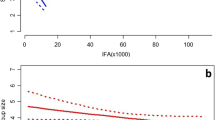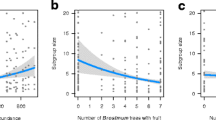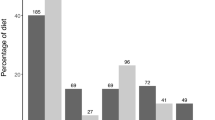Abstract
The adjustment to deal with intragroup food competition is probably the most plausible explanation of high levels of fission–fusion dynamics. However, studies did not always support expected relations between food availability, ranging costs, and subgroup size. We used several levels of analysis differing in the time and spatial scale in order to investigate this explanation in spider monkeys. In our study, subgroups were larger when food availability was higher across most levels of analyses used. We also found a fine-scale adjustment: compared to the food patch previously visited, spider monkeys traveled to larger patches just after fusions. This was not without an immediate travel cost: the interpatch distance and travel time after a fusion were longer than that before the fusion. This rapid adjustment shows the flexibility that fission–fusion dynamics can offer. Spider monkeys are in large subgroups only when food conditions are favorable, as evidenced by the fact that at all the other time-scale levels larger subgroups did not experience greater ranging costs than smaller subgroups. Our results indicate that on the whole spider monkeys successfully minimize ranging costs by fission and fusion of subgroups.





Similar content being viewed by others
References
Alexander RD (1974) The evolution of social behaviour. Ann Rev Ecolog Syst 5:325–383
Anderson DP, Nordheim EV, Boesch C, Moermond TC (2002) Factors influencing fission–fusion grouping in chimpanzees in the Tai National Park, Cote d’Ivoire. In: Boesch C, Hohmann G, Marchant LF (eds) Behavioural diversity in chimpanzees and bonobos. Cambridge University Press, New York, pp 90–101
Archie EA, Morrison TA, Foley CAH, Moss CJ, Alberts SC (2006) Dominance rank relationships among wild female African elephants (Loxodonta africana). Anim Behav 71:117–127
Asensio N, Korstjens AH, Schaffner CM, Aureli F (2008) Intragroup aggression, feeding competition and fission–fusion sociality in spider monkeys. Behaviour 145(7):983–1001
Aureli F, Schaffner CM, Boesch C, Bearder SK, Call J, Chapman CA, Connor R, Di Fiore A, Dunbar RIM, Henzi PS, Holekamp K, Korstjens AH, Layton R, Lee P, Lehmann J, Manson JH, Ramos-Fernandez G, Strier KB, van Schaik CP (2008) Fission–fusion dynamics: new research frameworks. Cur Anthropol 48:627–654
Basabose AK (2004) Fruit availability and chimpanzee party size at Kahuzi Montane Forest, Democratic Republic of Congo. Primates 45(4):211–219
Carbone C, Cowlishaw G, Isaac NJB, Rowcliffe J (2005) How far do animals go? Determinants of day range in mammals. Am Nat 165(2):290–297
Chapman CA (1988) Patterns of foraging and range use by three species of neotropical primates. Primates 29:177–194
Chapman CA (1990) Association patterns of male and female spider monkeys: the influence of ecology and sex on social organization. Behav Ecol Soc 26:409–414
Chapman CA, Chapman LJ (2000) Determinants of group size in primates: the importance of travel costs. In: Boinski S, Garber PA (eds) On the move: how and why animals travel in groups. University of Chicago Press, Chicago, pp 24–42
Chapman CA, Wrangham W (1994) Indices of habitat-wide abundance in tropical forests. Biotropica 26(2):160–171
Chapman CA, Chapman LJ, Wrangham W, Hunt D, Gebo D, Gardner L (1992) Estimators of fruit abundance of tropical trees. Biotropica 24:527–531
Chapman CA, Wrangham RW, Chapman LJ (1995) Ecological constraints on group size: an analysis of spider monkey and chimpanzee subgroups. Behav Ecol Soc 36(1):59–70
Clutton-Brock TH, Harvey PH (1977) Primate ecology and social organization. J Zool 183:1–39
Connor RC, Wells RS, Mann J, Read AJ (2000) The bottlenose dolphin, social relationships in a fission–fusion society. In: Mann J, Connor RC, Tyack PL, Whitehead H (eds) Cetacean societies: field studies of dolphins and whales. University of Chicago Press, Chicago, pp 91–126
Di Fiore A, Campbell CJ (2007) The atelines: variation in ecology, behavior, and social organization. In: Campbell A, Fuentes KC, Mackinnon KC, Panger M, Beader SK (eds) Primates in perspective. Oxford University Press, New York, pp 155–185
Dunbar RIM (1988) Primate social systems. Cornell University Press, Ithaca
Ghiglieri MP (1984) Feeding ecology and sociality of chimpanzees in Kibale Forest, Uganda. In: Rodman PS, Cant JGH (eds) Adaptations for foraging in nonhuman primates: contributions to an organismal biology of prosimians, monkeys, and apes. Columbia University Press, New York, pp 161–194
Hashimoto C, Suzuki S, Takenoshita Y, Yamagiwa J, Basabose AK, Furuichi T (2003) How fruit abundance affects the chimpanzee party size: a comparison between four study sites. Primates 44(2):77–81
Heithaus MR, Dill LM (2002) Food availability and tiger shark predation risk influence bottlenose dolphin habitat use. Ecology 83(2):480–491
Isbell LA (1991) Contest and scramble competition: patterns of female aggression and ranging behavior among primates. Behav Ecol 2(2):143–155
Itoh N, Nishida T (2007) Chimpanzee grouping patterns and food availability in Mahale Mountains National Park, Tanzania. Primates 48:87–96
Janson CH (1988) Intra-specific food competition and primate social structure: a synthesis. Behaviour 105(1–2):1–17
Janson CH, Goldsmith ML (1995) Predicting group size in primates: foraging costs and predation risks. Behav Ecol 6(3):326–336
Janson CH, van Schaik CP (1988) Recognizing the many faces of primate food competition: methods. Behaviour 105(1–2):165–186
Janzen DH (1986) Guanacaste National Park: ecological and cultural restoration. UNED, San Jose
Klein LL, Klein DB (1977) Feeding behaviour of the Colombian spider monkey. In: Clutton-Brock TH (ed) Primate ecology: studies of feeding and ranging behaviour in lemurs, monkeys and apes. Academic, New York, pp 153–181
Koenig A (2002) Competition for resources and its behavioral consequences among female primates. Int J Primatol 23(4):759–783
Korstjens AH, Verhoeckx IL, Dunbar RIM (2006) Time as a constraint on group size in spider monkeys. Behav Ecol Sociobiol 60:683–669
Kruuk H (1972) The spotted hyena: a study of predation and social behavior. University of Chicago Press, Chicago
Kummer H (1971) Primate societies: group techniques of ecological adaptation. Aldine-Atherton, Chicago
Lehmann J, Boesch C (2004) To fission or to fusion: effects of community size on wild chimpanzee (Pan troglodytes verus) social organisation. Behav Ecol Sociobiol 56(3):207–216
Lehmann J, Korstjens AH, Dunbar RIM (2007) Fission–fusion social systems as a strategy for coping with ecological constraints: a primate case. Evol Ecol 21:613–634
Lomnicki A (1988) Population ecology of individuals, monograph in population biology. Princeton University Press, New York
Mitani JC, Watts DP, Lwanga JS (2002) Ecological and social correlates of chimpanzee party size and composition. In: Boesch C, Hohmann G, Marchant LF (eds) Behavioural diversity in chimpanzees and bonobos. Cambridge University Press, New York, pp 102–111
Muller MN (2002) Agonistic relations among Kanyawara chimpanzees. In: Boesch C, Hohmann G, Marchant LF (eds) Behavioural diversity in chimpanzees and bonobos. Cambridge University Press, New York, pp 112–124
Newton-Fisher NE, Reynolds V, Plumptre AJ (2000) Food supply and chimpanzee (Pan troglodytes schweinfurthii) party size in the Budongo Forest Reserve, Uganda. Int J Primatol 21(4):613–628
Nicholson AJ (1954) Compensatory reactions of populations to stresses, and their evolutionary significance. Aust J Zool 2:1–8
Nishida T (1968) The social group of wild chimpanzees in the Mahali mountains. Primates 9:167–224
Ramos-Fernandez G, Boyer D, Gomez VP (2006) A complex social structure with fission–fusion properties can emerge from a simple foraging model. Behav Ecol Sociobiol 60(4):536–549
Siegel S, Castellan NJ (1988) Nonparametric statistics for the behavioural sciences. McGraw-Hill, New York
Smith JE, Kolowski JM, Graham SED, Holekamp KE (2008) Social and ecological determinants of fission–fusion dynamics in the spotted hyena. Anim Behav 76:619–636
Stephen DW, Krebs JR (1986) Monographs in behavior ecology. Princeton University Press, Princeton
Sterck EHM, Watts DP, van Schaik CP (1997) The evolution of female social relationships in nonhuman primates. Behav Ecol Sociobiol 41(5):291–309
Stevenson PR, Quinones MJ, Ahumada JA (1998) Effects of fruit patch availability on feeding subgroup size and spacing patterns in four primate species at Tinigua National Park, Colombia. Int J Primatol 19(2):313–324
Sugiyama Y (1999) Socioecological factors of male chimpanzee migration at Bossou, Guinea. Primates 40(1):61–68
Symington MM (1988) Food competition and foraging party size in the black spider monkey (Ateles paniscus chamek). Behaviour 105(1–2):117–134
Symington MM (1990) Fission–fusion social organization in Ateles and Pan. Int J Primatol 11(1):47–61
te Boekhorst IJA, Schurmann CL, Sugardjito J (1990) Residential status and seasonal movements of wild orangutans in the Gunung Leuser Reserve (Sumatera, Indonesia). Anim Behav 39:1098–1109
Terborgh J, Janson CH (1986) The socioecology of primate groups. Ann Rev Ecol Syst 17:111–136
van Schaik CP (1999) The socioecology of fission–fusion sociality in orangutans. Primates 40(1):69–86
van Schaik CP, van Hooff JARAM (1983) On the ultimate causes of primate social systems. Behaviour 85:91–117
Vogel ER, Janson CH (2007) Predicting the frequency of food-related agonism in white-faced capuchin monkeys (Cebus capucinus), using a novel focal-tree method. Am J Primatol 69:533–560
Wallace RB (2008) The influence of feeding patch size and relative fruit density on the foraging behaviour of the black spider monkey Ateles chamek. Biotropica 40(4):501–506
Williams JM, Liu HY, Pusey AE (2002) Costs and benefits of grouping for female chimpanzees at Gombe. In: Boesch C, Hohmann G, Marchant LF (eds) Behavioural diversity in chimpanzees and bonobos. Cambridge University Press, New York, pp 192–203
Wrangham RW (1979) On the evolution of ape social systems. Soc Sci Inf 18(3):335–368
Acknowledgements
We wish to thank Elvin Murillo-Chacon for the great support during the field study. Melanie Luinstra and Anne-Marie Nuttall are acknowledged for the help given with the mapping software. Gabriel Ramos-Fernandez, David Watts, and two anonymous reviewers are acknowledged for helpful comments. We thank also all the staff from Santa Rosa National Park, especially Roger Blanco and Maria Marta Chavarria, and the financial support from the Leakey Foundation and The North of England Zoological Society. N. Asensio was supported by The Department of Political Science of the Basque Government (Zientzia Politikarako Zuzendaritza). Observations complied with current laws in Costa Rica.
Author information
Authors and Affiliations
Corresponding author
Additional information
Communicated by D. Watts
Rights and permissions
About this article
Cite this article
Asensio, N., Korstjens, A.H. & Aureli, F. Fissioning minimizes ranging costs in spider monkeys: a multiple-level approach. Behav Ecol Sociobiol 63, 649–659 (2009). https://doi.org/10.1007/s00265-008-0699-9
Received:
Revised:
Accepted:
Published:
Issue Date:
DOI: https://doi.org/10.1007/s00265-008-0699-9




